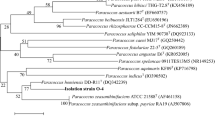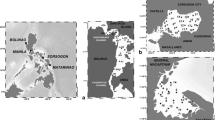Abstract
Harmful algal blooms (HABs) often cause great damage to the fish aquaculture industry in the western part of Japan. Bacteria that effectively kill such phytoplankton are found in coastal seawater and are considered to influence the occurrence of HABs. Algicidal bacteria are found in abundance in seagrass beds; however, the distribution of particular bacterial strains has not yet been clarified. In this study, we determined the abundance of three algicidal Alteromonas sp. strains that were isolated as Chattonella antiqua-killing bacteria in seagrass beds and their surrounding areas in summers of 2013–2015. The strains were detected using a quantitative polymerase chain reaction (qPCR) amplification method. Two of the three algicidal bacterial strains were remarkably abundant in the seawater of an enclosed seagrass bed compared to the surrounding areas. In addition, the abundance of the three algicidal bacteria decreased when the eelgrass withered in late summer. These results suggest that growth of these algicidal bacteria was stimulated by eelgrass. The bacterial abundance estimated by qPCR was much greater than that determined by the culture-dependent method in June 2015 when the eelgrass grew thickly. This implies that the qPCR assay could be a sensitive tool to evaluate algicidal bacteria in natural environments.






Similar content being viewed by others
References
Itakura S, Imai I (2014) Economic impacts of harmful algal blooms on fisheries and aquaculture in western Japan—an overview of inter annual variability and interspecies comparison. In: Trainer VL, Yoshida T (eds.) Proceedings of the Workshop on Economic Impacts of Harmful Algal Blooms on Fisheries and Aquaculture, PICES Sci Rep 47:17–26
Kaneda A, Koizumi Y, Takahashi D, Fukumori K, Guo X, Takeoka H (2010) Disappearance of the bloom of the harmful dinoflagellate Karenia mikimotoi induced by the occurrence of bottom intrusion in Shitaba Bay, Uwa Sea, in 2007. Bull Jpn Soc Fish Oceanogr 74:167–175 (in Japanese, with English abstract)
Imai I, Ishida Y, Sakaguchi K, Hata Y (1995) Algicidal marine bacteria isolated from northern Hiroshima Bay, Japan. Fish Sci 61:628–636
Nagasaki K, Tarutani K, Yamaguchi M (1999) Growth characteristics of Heterosigma akashiwo virus and its possible use as a microbiological agent for red tide control. Appl Environ Microbiol 65:898–902
Skerratt JH, Bowman JP, Hallegraeff G, James S, Nichols PD (2002) Algicidal bacteria associated with blooms of a toxic dinoflagellate in a temperate Australian estuary. Mar Ecol Prog Ser 244:1–15
Onji M, Nakano S, Suzuki S (2003) Virus-like particles suppress growth of the red-tide-forming marine dinoflagellate Gymnodinium mikimotoi. Mar Biotechnol (NY) 5:435–442
Kim MC, Yoshinaga I, Imai I, Nagasaki K, Itakura S, Ishida Y (1998) A close relationship between algicidal bacteria and termination of Heterosigma akashiwo (Raphidophyceae) blooms in Hiroshima Bay, Japan. Mar Ecol Prog Ser 170:25–32
Imai I, Sunahara T, Nishikawa T, Hori Y, Kondo R, Hiroishi S (2001) Fluctuations of the red tide flagellates Chattonella spp. (Raphidophyceae) and the algicidal bacterium Cytophaga sp. in the Seto Inland Sea, Japan. Mar Biol 138:1043–1049
Mayali X, Franks PJ, Azam F (2008) Cultivation and ecosystem role of a marine Roseobacter clade-affiliated cluster bacterium. Appl Environ Microbiol 74:2595–2603
Onishi Y, Mohri Y, Tuji A, Ohgi K, Yamaguchi A, Imai I (2014) The seagrass Zostera marina harbors growth-inhibiting bacteria against the toxic dinoflagellate Alexandrium tamarense. Fish Sci 80:353–362
Imai I (2015) Interactions between harmful algae and algicidal and growth-inhibiting bacteria associated with seaweeds and seagrasses. In: Ohtsuka S, Suzaki T, Horiguchi T, Suzuki N, Not F (eds) Marine protists. Springer, Tokyo, pp 597–619
Inaba N, Watanabe T, Sakami T, Nishi H, Tahara Y, Imai I (2014) Temporal and spatial distribution of algicidal and growth-inhibiting bacteria in the coastal sea of southwest Japan. J Plankton Res 36:388–397
Park JH, Yoshinaga I, Nishikawa T, Imai I (2010) Algicidal bacteria in particle-associated form and in free-living form during a diatom bloom in the Seto Inland Sea, Japan. Aquat Microb Ecol 60:151–161
Douterelo I, Boxall JB, Deines P, Sekar R, Fish KE, Biggs CA (2014) Methodological approaches for studying the microbial ecology of drinking water distribution systems. Water Res 65:134–156
Joyner J, Wanless D, Sinigalliano CD, Lippb EK (2014) Use of quantitative real-time PCR for direct detection of Serratia marcescens in marine and other aquatic environments. Appl Environ Microbiol 80:1679–1683
Rueckert A, Wood SA, Cary SC (2007) Development and field assessment of a quantitative PCR for the detection and enumeration of the noxious bloom-former Anabaena planktonica. Limnol Oceanogr Meth 5:474–483
Behrendt L, Nielsen JL, Sorensen SJ, Larkum AWD, Winther JR, Kuhla M (2014) Rapid TaqMan-based quantification of chlorophyll d-containing cyanobacteria in the genus Acaryochloris. Appl Environ Microbiol 80:3244–3249
Ryu H, Henson M, Elk M, Toledo-Hernandez C, Griffith J, Blackwood D, Noble R, Gourmelon M, Glassmeyer S, Santo Domingo JW (2013) Development of quantitative PCR assays targeting the 16S rRNA genes of Enterococcus spp. and their application to the identification of Enterococcus species in environmental samples. Appl Environ Microbiol 79:196–204
Imai I, Yamaguchi M, Hori Y (2006) Eutrophication and occurrences of harmful algal blooms in the Seto Inland Sea, Japan. Plankton Benthos Res 1:71–84
Tanda M, Akashige S, Ariyama H, Yamanoi H, Kimura H, Dan A, Sakamoto H, Saiki Y, Ishida Y, Kotobuki H, Yamada T (2014) Nutrient environment and fisheries in the Seto Inland Sea. J Fish Tech 7:37–46 (in Japanese, with English abstract)
Tanaka T (2014) Satoumi with eelgrass and oyster beds, “Hinasesengen-ryoshimachi” (Hinase, Okayama). Nippon Suisan Gakkaishi 80:72–75 (in Japanese)
Fujiwara M (2013) Research on appropriate creation technology for Zostera beds in and around the coastal shallow areas, Seto-Inland Sea. Bull Kagawa Pref Fish Exp Stn 14:1–51 (in Japanese)
Miyajima T, Koike I, Yamano H, Iizumi H (1998) Accumulation and transport of seagrass-derived organic matter in reef flat sediment of Green Island, Great Barrier Reef. Mar Ecol Prog Ser 175:251–259
de Wit R, Troussellier M, Courties C, Buffan-Dubau E, Lemaire E (2012) Short-term interactions between phytoplankton and intertidal seagrass vegetation in a coastal lagoon (Bassin d’Arcachon, SW France). Hydrobiologia 699:55–68
Guillard RR, Ryther JH (1962) Studies of marine planktonic diatoms. I. Cyclotella nana Hustedt and Detonula confervaceae (Cleve) Gran. Can J Microbiol 8:229–239
Esaki T, Ohtusu K (2006) Identification of intestinal flora: DNA probe and primers. J Intest Microbiol 20:245–258 (in Japanese)
Lloyd KG, Macgregor BJ, Teske A (2010) Quantitative PCR methods for RNA and DNA in marine sediments: maximizing yield while overcoming inhibition. FEMS Microbiol Ecol 72:143–151
Gonzaga A, López-Pérez M, Martin-Cuadrado AB, Ghai R, Rodriguez-Valera F (2012) Complete genome sequence of the copiotrophic marine bacterium Alteromonas macleodii strain ATCC 27126T. J Bacteriol 194:6998
Lee SO, Kato J, Takiguchi N, Kuroda A, Ikeda T, Mitsutani A, Ohtake H (2000) Involvement of an extracellular protease in algicidal activity of the marine bacterium Pseudoalteromonas sp. strain A28. Appl Environ Microbiol 66:4334–4339
Nakashima T, Miyazaki Y, Matsuyama Y, Muraoka W, Yamaguchi K, Oda T (2006) Producing mechanism of an algicidal compound against red tide phytoplankton in a marine bacterium γ-proteobacterium. Appl Microbiol Biotechnol 73:684–690
Paul C, Pohnert G (2011) Interactions of the algicidal bacterium Kordia algicida with diatoms: regulated protease excretion for specific algal lysis. PLoS One 6:e21032
Yoshinaga I, Kawai T, Ishida Y (1995) Lysis of Gymnodinium nagasakiense by marine bacteria. In: Lassus P, Arzul G, E-Le Denn E, Gentien P, Marcaillou-LeBaut C (eds) Harmful marine algal blooms. In: Proceedings of the Sixth International Conference on Toxic Marine Phytoplankton. pp 687–692
Penhale PA, Smith WO (1977) Excretion of dissolved organic carbon by eelgrass (Zostera marina) and its epiphytes. Limnol Oceanogr 122:403–407
Acknowledgements
We are grateful to Dr. I. Yoshinaga of the Tottori University of Environmental Studies, Mr. T. Katayama of Ocean Construction, and Mr. S. Kojima for their helpful advice and cooperation in the study. This study was supported financially by the Agriculture, Forestry, and Fisheries Research Council.
Author information
Authors and Affiliations
Corresponding author
Rights and permissions
About this article
Cite this article
Sakami, T., Sakamoto, S., Takagi, S. et al. Distribution of three algicidal Alteromonas sp. strains in seagrass beds and surrounding areas in the Seto Inland Sea, Japan. Fish Sci 83, 113–121 (2017). https://doi.org/10.1007/s12562-016-1048-y
Received:
Accepted:
Published:
Issue Date:
DOI: https://doi.org/10.1007/s12562-016-1048-y




